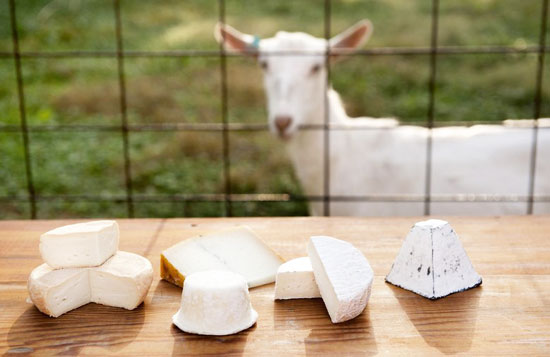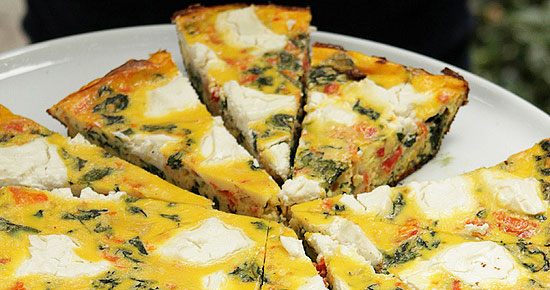Six goat cheese benefits, nutrition facts and recipes (2)
Read the first part of the article
Goat Cheese Nutrition

Studies have found that, depending on how goat cheese is cured and aged, a wide variation exists in terms of the concentrations of nutrients, such as phosphorus, vitamin K, calcium, iron, sodium and zinc. Softer cheeses tend to be lower in calories, fat, protein and most of the minerals mentioned above compared to harder cheeses that have been aged longer.
A one-ounce (28 g) serving of soft goat cheese has about:
• 75 calories;
• 0.2 gram carbohydrates;
• 5.2 grams of protein;
• 5.9 grams of fat (slightly less than most other cheeses);
• 0.2 milligram copper (10 percent DV – daily recommended value);
• 71.7 milligrams phosphorus (7 percent DV);
• 0.1 milligram riboflavin/vitamin B2 (6 percent DV);
• 289 international units vitamin A (6 percent DV);
• 39.2 milligrams calcium (4 percent DV);
• 0.1 milligram vitamin B6 (4 percent DV);
• 0.5 milligram of iron (3 percent DV).
Goat Cheese vs. Cow Cheese vs. Other Cheese
Is goat cheese better for you than other cheese, such as feta or cheddar? Here’s how goat cheese stacks up against other cheeses:
• Goat cheese has less calories, fat and protein than many cheeses made with cow’s milk, such as cheddar, brie or gouda cheese;
• Feta cheese, popular in Greece and parts of the Mediterranean and Middle East, has traditionally been made from goat’s milk (or sometimes sheep’s milk);
• Cheeses made from sheep’s milk – such as Roquefort, manchego, pecorino romano – are other great options. Sheep milk is even higher in many vitamins and minerals than cow’s and goat’s milk, including vitamin B12, vitamin C, folate and magnesium. Compared to goat’s cheese, sheep’s milk cheese is less tangy and usually creamier.
Where to Find and How to Use Goat Cheese
Wondering where to buy goat cheese if you’re concerned about getting the best quality? Check your local farmer’s market for organic goat cheese, or even consider buying organic cheeses online. Depending on how you plan on using goat cheese you might want to try different varieties, including soft, semi-soft, hard, fig, honey, pepper, garlic and herb cheeses.
The best goat cheese brands are those that use organic goat’s milk from grass-fed animals that are not treated with hormones or antibiotics. Although raw cheeses can be harder to find, buy them whenever possible because they contain more enzymes and beneficial bacteria due to avoiding high-heat pasteurization. Certain studies have found that the quality of cheese affects the actual chemical composition of the cheese. One analysis of 60 different samples of goat cheese found that farm-produced cheese had more dry matter, high protein levels and more fat. Goat cheeses from farms contained higher concentrations of lactoferrin caprine and serum albumin proteins compared to cheeses produced in factories.
What are some of the ways you can use goat cheese? Goat cheese goes well with flavors and foods like honey; dates or figs; eggs; beets; herbs like oregano, basil and parsley; black pepper; spinach; arugula; kale; avocado; tomatoes; and eggplant. Popular uses of goat cheese include adding some to salads or omelettes/frittatas, serving goat cheese with roasted beets and balsamic dressing, adding some to sandwiches or collard wraps, and topping veggies with crumbled goat cheese.
Goat Cheese Recipes
Here’s a basic recipe for making soft goat cheese (also called chevre):
Ingredients:
• 1 gallon of goat’s milk (raw, organic goat’s milk that has not been pasteurized);
• 1 packet chevre culture (purchase enough culture to set 1 gallon of milk; look for one that includes culture and rennet for cheese making);
• 2 teaspoons salt;
• thermometer;
• knife;
• spoon or ladle;
• butter muslin or large colander.
Directions:
Warm the milk to 68–72 degrees F (20–22°C) in a pot over low heat.
Add the culture by sprinkling it over the top of the milk. Wait about 2 minutes for the culture to rehydrate, then stir.
Place a cloth over the pot and let the milk sit in the pot at room temperature for 6-12 hours.
Once you see that the curd has formed (and there’s a thin layer of whey over the curd mass), drain the whey from the curd using a colander. The curd will drain slowly over about 6 hours or more. The more time you allow for the curd to drain, the drier and tangier the cheese will be. You can slowly keep draining for about 24-36 hours to form a dense cheese. Softer, sweeter cheeses need less time to drain.
Once the cheese has drained to your preference, add about 1.5-2 teaspoons of salt and any herbs you might like. Store the cheese in the refrigerator in a bowel and use within about 7-10 days.
Below are some ideas for using goat cheese in healthy recipes, whether the cheese is homemade or store-bought:
• Caramelized Onion, Goat Cheese and Rosemary Mac n’ Cheese Recipe
• Berry Goat Cheese Recipe
• Creamy Goat Cheese and Artichoke Dip Recipe
• Eggplant Wrapped Goat Cheese Recipe

Goat Cheese History and Facts
According to the Original Chevre website, “Authentic, artisanal French chèvre has been passed down between generations of farmers for thousands of years.” With its long history of goat cheese consumption, France continues to be one of the biggest producers of several types of goat’s milk cheeses, commonly called French chèvres (chèvre in French simply means goat).
Geography, geology and climate all dictate the varieties of cheese made from goat’s milk. Milk quality and taste are directly linked to the land, or terroir, where the goats roam. Varieties of goat cheese have been traditionally made in Australia, Greece, China, Italy, Norway, Turkey, U.S., U.K., Netherlands, Ireland and in the Eastern region of the Middle East (where Labneh cheese is often made with goat’s or sheep’s milk). In ancient Greece, goats were considered “legendary animals.
According to Eurial International (a supplier of goat’s milk), “Settling down around 7,000 BC, the prehistoric nomadic hunter created the first goat cheeses, becoming the forerunner of all cheeses. During the Greek and Roman civilisation, goats adapted well to arid areas of the Mediterranean. In the Middle Ages goat cheeses were used as money, as well as food for the pilgrims.”
Goat cheese consumption has risen in the U.S. over the past several decades as goat’s cheese has become known for being healthier than other cheeses. In fact, according to the Agricultural Marketing Resource Center, “in the past decade goat cheese has been one of the fastest growing cheeses in the specialty food product market”. Currently, more than 50 percent of the goat cheese products consumed in the U.S. are imported, mostly from France. The most popular type of goat cheese available in the U.S. is chevre, a fresh, soft cheese similar in texture to cream cheese that is usually sold in logs, often with added flavoring from berries, herbs or nuts.
Precautions
If you have a known allergy to cow’s milk, or lactose intolerance, incorporate goat cheese into your diet slowly to make sure you don’t have a negative reaction. Even though it’s less allergenic than cow’s milk, it’s still possible to be allergic to goat (or sheep’s) milk products. Consume goat cheese carefully if you’ve ever experienced a histamine response to goat’s milk products. Stop eating goat cheese and other dairy products if you experience symptoms like hives, sweating, diarrhea, abdominal pain or swelling.
Pregnant women are advised not to consume raw cheeses due to the potential for bacterial contamination, so to be safe it’s best to either avoid eating questionable cheeses during pregnancy or to always purchase from a reputable retailer that you trust.
Final Thoughts on Goat Cheese Benefits
• Goat cheese is typically a soft or semi-soft cheese made from goat’s milk that has a tangy taste and smooth texture.
• Benefits of goat cheese include that it provides calcium, healthy fats, probiotics, phosphorus, copper, protein, B vitamins and iron.
• Goat’s cheese is a good alternative to cow’s milk cheeses because it’s lower in lactose, contains type 2 casein protein, is typically easier to digest, and is usually much less allergenic and inflammatory.
yogaesoteric
February 11, 2019
